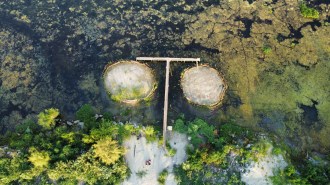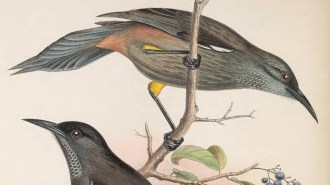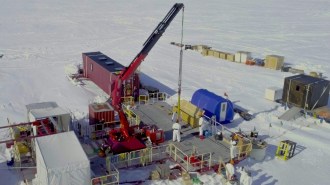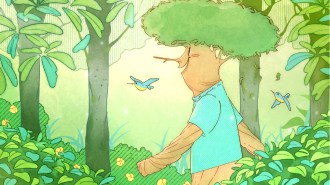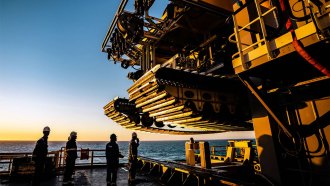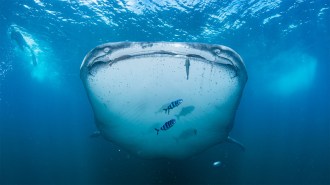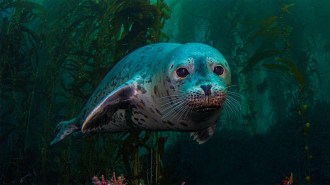Shrinking sea ice threatens natural highways for caribou, plants
Both furry and flowery travelers face trouble in a warmer world
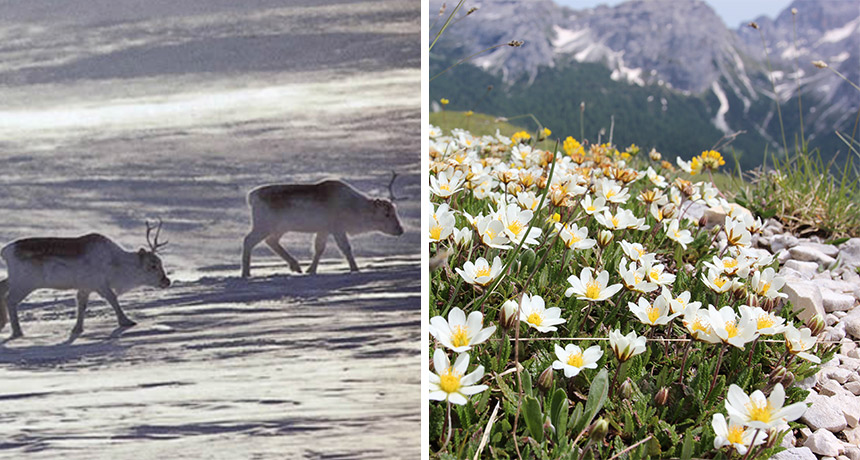
ICE TRAVELERS Shrinking sea ice matters to land dwellers too, as ice bridges and transport dwindles for migrating Peary caribou (left) and seed dispersing mountain avens flowers (right).
From left: L. David Mech/Wikimedia Commons (CC BY-SA 3.0); Steinsplitter/Wikimedia Commons (CC BY-SA 3.0)
As warming breaks up the sea ice that serves as great frozen highways for Arctic wildlife, caribou and even wildflowers face route shutdowns, long detours or outright strandings.
Already, ice bridges Peary caribou need for their seasonal migrations from island to island are becoming scarcer, with worse to come, an international research team reports September 21 in Biology Letters. In the same issue, other researchers suggest that even some plants need the icy travel routes: Ancestors of dozens of wildflower and miniature tree species probably used sea ice to colonize the far north after the last ice age.
Both studies point to the worrisome possibility that Arctic plants and animals will face increasing difficulties sustaining their populations as their territories become more fragmented. “We often hear about the loss of sea ice, but rarely about the biological consequences,” says Deborah Jenkins of Trent University in Peterborough, Canada, who worked on the caribou project.
Ice bridges let Arctic foxes move such long distances, for instance, that genetic studies have registered basically a big, interconnected population trotting around northern archipelagos from North America to Svalbard, north of Norway. The new study is the first to report on how sea ice affects migration among some of the Arctic’s storied caribou, says coauthor Glenn Yannic of University Savoie Mont Blanc in Chambéry, France.
Of the three subspecies of caribou, Peary caribou (Rangifer tarandus pearyi) depend the most heavily on sea ice highways. The animals live mostly in the more than 36,000 islands of the Canadian Arctic Archipelago, rarely coming south to the mainland to mingle with other subspecies. Caribou can swim but in practice rarely paddle more than 10 kilometers, Yannic says. But they can walk long distances, up to 380 kilometers. In the spring, they walk across ice bridges to their local calving ground; at the end of the season, they walk back.
Travel among those islands has already gotten tougher, the researchers report, possibly requiring more roundabout routes. By analyzing patterns of fluctuating sea ice throughout the islands, the team shows that these landscapes have become 15 percent more difficult to traverse since 1979. If carbon dioxide emissions remain high, the ice bridges will probably shrink enough to make finding paths another 20 to 77 percent more difficult, the researchers calculate.
Though plants don’t walk, biologists have theorized that seeds too could travel sea ice highways by snagging on the feet or fur of a moving animal. Or the slow creep of ice itself could nudge an embedded seed from, say, northern Russia to Iceland in a few years. The second study provides the first empirical evidence for plant transit by ice, says study coauthor Inger Greve Alsos of the Arctic University of Norway in Tromsø.
She and her colleagues reconstructed probable routes for plants recolonizing parts of the far north (Iceland, Svalbard, East Greenland and the Faroe Islands) since the end of the last ice age. They studied pollen grains pulled from gunk in lake bottoms and other evidence to track the earliest known appearances of 102 species in the northern frontier.
The shortest sea routes between the plants’ likely origins and destinations were unusually rich in sea ice around the time of colonization, the researchers say, suggesting that abundant ice could have been useful for plant travel.
The study didn’t look at what impact sea ice changes are currently having on these plants. But the rate of sea ice loss since 1979 has been about equivalent to an area twice the size of New Jersey disappearing annually, says Eric Post of University of California, Davis. “Its loss, in ecological terms, could be likened to the ongoing clear-cutting of old-growth forest, year after year after year,” he says.
Travel trouble for caribou and plants is just the tip of the iceberg when it comes to the impact of sea ice changes (SN Online: 9/19/16). For instance, as ice dwindles, extra sunlight reaching into the Arctic Ocean has fueled more than a 30 percent surge in growth of photosynthesizing marine plankton, says Kevin Arrigo of Stanford University. Sea ice is so important to Arctic life that changes it brings — both gains and losses — can be dramatic.
Editor’s note: This story was updated October 7, 2016, to correct the distances that caribou can swim and walk, and the potential impact of ice shrinkage on the animals’ ability to find paths.
